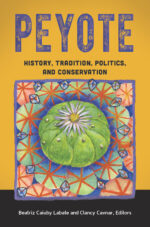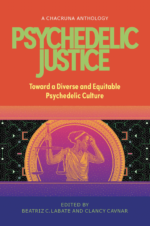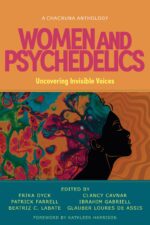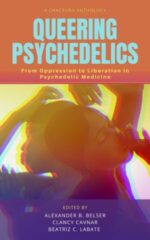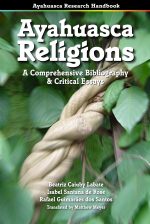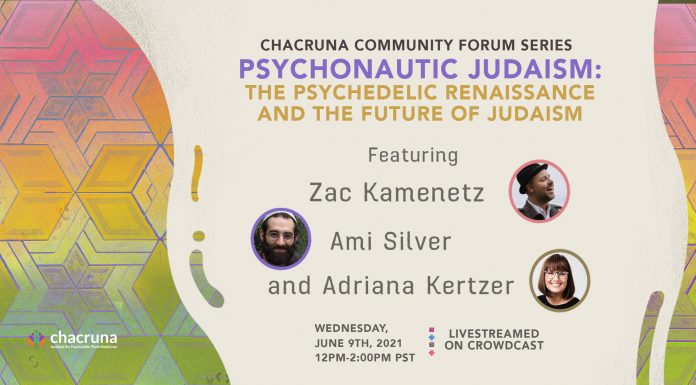- Meet Chacruna at Psychedelic Science 2025 - May 27, 2025
- Psychedelics and Attachment: Fundamentals, Implications, and New Frontiers - May 16, 2025
- Development Outreach Internship (OPEN) - May 6, 2025
Read Allison Hoots and Rebecca Lee Whiting’s explanation of this brief HERE.
ORAL ARGUMENT NOT SCHEDULED
No. 23-5122
In the United States Court of Appeals for the District of Columbia Circuit
Iowaska Church of Healing,
Plaintiff-Appellant
v.
Daniel I. Werfel, in his Official Capacity as Commissioner, Internal Revenue Service; United States of America,
Defendants-Appellees
On Appeal from the United States District Court, District of Columbia,
No. 1:21-cv-02475, Hon. Beryl A. Howell, Judge Presiding
Brief of the Chacruna Institute for Psychedelic Plant Medicines and Sacred Plant Alliance as Amici Curiae In Support of Plaintiff-Appellant Iowaska Church of Healing
YETTER COLEMAN LLP
Matthew C. Zorn
[email protected]
David J. Gutierrez
[email protected]
811 Main Street, Suite 4100
Houston, Texas 77002
713-632-8000
EPIGRAM LEGAL P.C.
Rebecca Lee Whiting
[email protected]
548 Market Street, Suite 46925
San Francisco, CA 94104
415-335-6850
HOOTS LAW PRACTICE PLLC
Allison Hoots
[email protected]
P.O. Box 565
Accord, NY 12404
301-452-2213
Certificate as to Parties, Rulings, and Related Cases
No. 23-5122
In accordance with D.C. Circuit Rule 28(a)(1), amici curiae state as follows:
I. Parties and Amici Curiae
Except for the following, all parties, intervenors, and amici appearing in this Court are listed in the Brief for Appellant at page i.
Amici curiae in support of Appellant are the Chacruna Institute for Psychedelic Plant Medicines and Sacred Plant Alliance.
II. Rulings Under Review
References to the rulings at issue appear in the Brief of Appellants at page i.
III. Related Cases
Amici curiae are aware of no other related cases.
Rule 26.1 Disclosure Statement
Pursuant to Federal Rule Appellate Procedure 26.1, amici curiae state as follows:
The Chacruna Institute for Psychedelic Plant Medicines (“Chacruna”) is a registered 501(c)(3) California nonprofit corporation. Chacruna has no parent corporation and issues no stock. No publicly-held company has 10% or greater ownership in Chacruna.
Sacred Plant Alliance (“SPA”) is an interfaith association of churches operating as a California religious nonprofit corporation. SPA has no parent corporation and issues no stock. No publicly-held company has 10% or greater ownership in SPA.
- Certificate as to Parties, Rulings, and Related Cases
- Rule 26.1 Disclosure Statement
- TABLE OF AUTHORITIES
- GLOSSARY
- STATUTES AND REGULATIONS
- Interest of Amici Curiae & Authority to File
- Statement of Authorship and Financial Contribution
- Introduction and Summary of the Argument
- RELEVANT BACKGROUND
- A. RFRA to protect religious freedom, particularly the religious freedom of sacrament religions.
- B. RFRA does not permit the government to categorically prohibit the sacramental consumption of ayahuasca.
- C. DEA produces “interim” 2009 Guidelines for RFRA-based exemption applications.
- D. No formal rules have yet been promulgated, contradicting DEA’s prior representations.
- E. The district court erroneously concluded the Church lacked standing to assert RFRA claims against the IRS.
- ARGUMENT
- A. The Church has Article III standing.
- 1 The Church’s injuries are traceable to Defendants-Appellees and redressable by the relief sought.
- 2. The court erroneously upheld the IRS’s categorical approach in contravention of O Centro.
- 3. Alternatively, DEA should have been joined sua sponte.
- B. The Church should not be required to exhaust an unlawful and illusory administrative process.
- 2. The court erred when it held the only way that ayahuasca use is legal is with a DEA exemption.
- CONCLUSION
- Certificate of Compliance
- Certificate of Service
TABLE OF AUTHORITIES
CASES
Am. Tort Reform Ass’n v. Occupational Safety & Health Admin., 738 F.3d 387 (D.C. Cir. 2013)
Arizona Yage Assembly v. Garland, 2023 WL 3246927 (D. Ariz. May 4, 2023)
Ass’n of Flight Attendants-CWA, AFL-CIO v. Huerta, 785 F.3d 710 (D.C. Cir. 2015)
Bob Jones Univ. v. United States, 461 U.S. 574 (1983)
Burwell v. Hobby Lobby Stores, Inc., 573 U.S. 682 (2014)
Church of the Holy Light of the Queen v. Mukasey, 615 F.Supp.2d 1210 (D. Or. 2009), vacated in part sub nom. Church of Holy Light of Queen v. Holder, 443 Fed. Appx. 302 (9th Cir. 2011)
Collins v. Yellen, 141 S. Ct. 1761 (2021)
Daimler Trucks N. Am. LLC v. E.P.A., 737 F.3d 95 (D.C. Cir. 2013)
Eco Tour Adventures, Inc. v. Zinke, 249 F.Supp.3d 360
Empl. Div., Dep’t of Human Res. of Ore. v. Smith, 494 U.S. 872 (1990)
Gonzales v. O Centro Espirita Beneficente Uniao do Vegetal, 546 U.S. 418 (2006)
Guardian Fed. Sav. & Loan Ass’n v. Fed. Sav. & Loan Ins. Corp., 589 F.2d 658 (D.C. Cir. 1978)
Iowaska Church of Healing v. United States, 2023 WL 2733774 (D.D.C. Mar. 31, 2023)
La Casa Del Convaleciente v. Sullivan, 965 F.2d 1175 (1st Cir. 1992)
MedImmune, Inc. v. Genentech, Inc., 549 U.S. 118 (2007)
Nat’l Mining Ass’n v. McCarthy, 758 F.3d 243 (D.C. Cir. 2014)
Navajo v. U.S., 535 F.3d 1058 (9th Cir. 2008)
Oklevueha Native Am. Church of Haw., Inc. v. Holder, 676 F.3d 829 (9th Cir. 2012)
Perez v. Mortgage Bankers Ass’n, 575 U.S. 92 (2015)
Sch. Dist. of Abington Twp., Pa. v. Schempp, 374 U.S. 203 (1963)
Shalala v. Guernsey Mem’l Hosp., 514 U.S. 87 (1995)
Sherbert v. Verner, 374 U.S. 398 (1963)
Singh v. Berger, 56 F.4th 88 (D.C. Cir. 2022)
Singh v. McHugh, 185 F.Supp.3d 201 (D.D.C. 2016)
Skyline Wesleyan Church v. Cal. Dep’t of Managed Health Care, 959 F.3d 341 (9th Cir.), amended and superseded on reh’g, 968 F.3d 738 (9th Cir. 2020)
Thomas v. Review Bd. of Indiana Emp. Sec. Div., 450 U.S. 707 (1981)
Tierney v. Schweiker, 718 F.2d 449 (D.C. Cir. 1983)
United States v. Philadelphia Yearly Meeting of the Religious Soc’y of Friends, 322 F.Supp.2d 603 (E.D. Pa. 2004)
United States v. Texas, 143 S. Ct. 1964 (2023)
Wisconsin v. Yoder, 406 U.S. 205 (1972)
STATUTES
5 U.S.C. § 553(b)(A)
21 U.S.C. §812 et seq
42 U.S.C. § 2000bb(a)(4)
42 U.S.C. § 2000bb(b)
42 U.S.C. § 2000bb(b)(1)
42 U.S.C. § 2000bb et seq
42 U.S.C. § 2000bb-1
42 U.S.C. § 2000bb-1(a)
42 U.S.C. § 2000bb-1(b)
42 U.S.C. § 2000bb-1(c)
Fed. R. Civ. P. 19(a)(1)
Fed. R. Civ. P. 21
IRC § 508(c)(1)(A)
OTHER AUTHORITIES
Allison Hoots, Guide to RFRA and Best Practices for Psychedelic Plant Medicine Churches, Chacruna Institute for Psychedelic Plant Medicines (2021), https://chacruna.net/guide_rfra_best_practices_psychedelic_churches/
Brad Bartlett, The U.S. Drug Enforcement Administration Problematic Process for Religious Exemption for Use of Prohibited Psychoactive Substances, Chacruna Institute for Psychedelic Plant Medicines (July 16, 2019), https://chacruna.net/the-u-s-drug-enforcement-agencys-problematic-process-for-religious-exemption-for-use-of-prohibited-psychoactive-substances/
Guidance Regarding Petitions for Religious Exemption from the Controlled Substances Act Pursuant to the Religious Freedom Restoration Act (www.deadiversion.usdoj.gov/GDP/(DEA-DC-5)(EO-DEA-007)(Version2)RFRA_Guidance_(Final)_11-20-2020.pdf)
H.R. Rep. No. 102-137, pt. 16 (1991)
IRS, Publication 557 29 (2023), https://www.irs.gov/pub/irs-pdf/p557.pdf
IRS, Tax Guide for Churches and Religious Organizations (2015), https://www.irs.gov/pub/irs-pdf/p1828.pdf
IRS, Audit Technique Guide – Organizations Conducting Gaming Activities, https://www.irs.gov/pub/irs-tege/atg_gaming.pdf (last visited Oct. 17, 2023)
Martha Hartney, DEA and the Religious Exemption: A Fox Guarding the Henhouse, Chacruna Institute for Psychedelic Plant Medicines (Oct. 13, 2020), https://chacruna.net/dea-prohibition-religious-freedom-ayahuasca-ceremonies/
Office of Information & Regulatory Affairs, Agency Rule List, www.reginfo.gov/public/do/eAgendaMain?operation=OPERATION_GET_AGENCY_RULE_LIST¤tPubId=202104&showStage=active&agencyCd=1100&csrf_token=B5480482A26248A678E3AB9255B09C6F75F0467E166F5831A29F8F7E9382318B29C99FF42F93D42180B900DFC739E01550C7
S. Rep. No. 103-111 (1993)
Victoria Litman, Psychedelics, the DEA, and Regulating Religion, Regulation, Spring 2023, https://www.cato.org/regulation/spring-2023/psychedelics-dea-regulating-religion

Shop our Collection of Psychedelic T-Shirts.
GLOSSARY
CSA – Controlled Substances Act, 21 U.S.C. § 812 et seq.
DEA – Drug Enforcement Administration
IRS – Internal Revenue Service
RFRA – Religious Freedom Restoration Act, 42 U.S.C. § 2000bb et seq.
STATUTES AND REGULATIONS
Pertinent statutes and regulations are cited throughout the brief.
Interest of Amici Curiae & Authority to File
Amici curiae are nonprofit organizations providing research, education, and advocacy regarding the rights of churches like Plaintiff-Appellant to practice their sincere beliefs under the Religious Freedom Restoration Act (“RFRA”).
Chacruna is a 501(c)(3) non-profit dedicated to providing research and education regarding plant and psychedelic sacraments. Chacruna advocates the continued protection under RFRA of the religious use of psychedelic sacraments, including ayahuasca.
SPA is an association of churches fostering mutual support and education, supporting the development of church leaders and of best practices for church operations, and creating accountability for religious sacrament churches. SPA’s mission is to facilitate the collaboration of churches in educating members and the public about their rights and best practices regarding entheogenic sacraments, and SPA is dedicated to ensuring the continued legal protection of the sincere, safe, and ethical religious use of entheogens within the United States.
All Parties consented to the filing of this brief. A notice of intent to file a brief as amici curiae under Circuit Rule 29(b) has been filed.
Statement of Authorship and Financial Contribution
No party’s counsel authored the brief in whole or in part, no party or party’s counsel contributed money that was intended to fund preparing or submitting the brief, and no person other than amici, their members, or their counsel contributed money that was intended to fund preparing or submitting the brief.
Introduction and Summary of the Argument
This appeal involves a church’s right to exercise its sincere religious beliefs—a right protected by the Religious Freedom Restoration Act (“RFRA”), 42 U.S.C. § 2000bb et seq.
The IRS concluded that Plaintiff-Appellant Iowaska Church of Healing (the “Church”) was “not organized and operated exclusively for exempt purposes” under Section 501(c)(3) of the Internal Revenue Code (the “Code”) because the Church’s planned religious “activities” involving the sacramental consumption of ayahuasca are categorically “illegal under fe[deral] law and violate public policy.” Iowaska Church of Healing v. United States, et al., 1:21-cv-02475-BAH, Dkt. 29-15 at 1. According to the IRS, absent an express exemption from the Controlled Substances Act (“CSA”), 21 U.S.C. § 812 et seq., the Church was not only engaged in illegal activity, it also was “not a church … within the meaning of section 170(b)(1)(A)(i) of the code.” Id. (emphasis added).
In response, the Church sued the IRS and the United States, arguing its ayahuasca use was religious and protected by RFRA. Dkt. 16 (“Compl.”). The district court granted summary judgment to Defendants-Appellees, holding in part that the Church lacked standing to assert RFRA claims against the IRS. Iowaska Church of Healing v. United States, 2023 WL 2733774, *6-7 (D.D.C. Mar. 31, 2023) (“Op.”). This was error.
First, the Church has standing to assert claims against the United States and the IRS, because the Church suffered concrete religious, reputational, and economic injuries traceable to Defendants-Appellees that are redressable by the relief sought. The IRS’s denial of 501(c)(3) status to the Church, based on the IRS’s categorical determination that using ayahuasca without a DEA exemption is always illegal—even in the Church’s sincere religious ceremonies—directly harms the Church by denigrating its religious beliefs as illegal practices and by depriving it of the many benefits of tax-exempt status. Moreover, those claims have merit, because the IRS’s categorical approach is inconsistent with the particularized review the Supreme Court has held is required under RFRA.
Second, the district court erred by treating DEA’s 2009 Guidance Regarding Petitions for Religious Exemption from the Controlled Substances Act Pursuant to the Religious Freedom Restoration Act (www.deadiversion.usdoj.gov/GDP/(DEA-DC-5)(EO-DEA-007)(Version2)RFRA_Guidance_(Final)_11-20-2020.pdf, revised Nov. 2020) (the “2009 Guidance”) as if it has the force and effect of law. It does not. The 2009 Guidance is neither a legislative rule nor binding interpretive rule and therefore cannot require administrative exhaustion. Moreover, under RFRA, the court had express authority to rule on the legality of the Church’s religious ayahuasca use, regardless of the Church’s separate CSA exemption application to DEA, which was filed in 2019 and remains unanswered. The court’s holding below unlawfully requires the Church to exhaust an illusory process with DEA, which was not promulgated via rulemaking, after the Church had suffered concrete injury from a different agency, the IRS.
In sum, the IRS failed to conduct the particularized inquiry required by RFRA, and the district court, on review, deferred to a DEA administrative process that lacks the force and effect of law. Taken together, the IRS’s categorical conclusion that sacramental use of a controlled substance is always illegal absent a DEA exemption, along with DEA’s administrative stonewalling, indefinitely prohibits sacramental churches like the Church from exercising their sincerely held religious beliefs, which violates both the letter and the spirit of RFRA and Supreme Court precedent.
For these reasons, this Court should reverse and remand.
RELEVANT BACKGROUND
Plaintiff-Appellant’s opening brief recounts the relevant procedural history. Amici will instead focus on the case law and administrative history that has led to the harmful predicament today, where churches whose sacraments are controlled substances are prevented from practicing their sincere religious beliefs in contravention of RFRA’s clear mandate and binding Supreme Court precedent.
The federal government is treating such sacramental uses, including ceremonial use of ayahuasca, as categorically illegal absent a DEA-granted exemption from the CSA. And the government has refused, through both IRS’s avoidance and DEA’s inaction, to create valid administrative processes by which churches may timely receive recognition of their tax-exempt church status and exemption from the CSA, respectively, as RFRA requires.
A. RFRA to protect religious freedom, particularly the religious freedom of sacrament religions.
The First Amendment’s free exercise clause protects the exercise of religious beliefs against restraint by the government. See Sch. Dist. of Abington Twp., Pa. v. Schempp, 374 U.S. 203, 222-23 (1963). Historically, this required applying strict scrutiny to any government action that impinged religious freedom. See, e.g., Wisconsin v. Yoder, 406 U.S. 205 (1972); Sherbert v. Verner, 374 U.S. 398 (1963).
In Employment Division, Department of Human Resources of Oregon v. Smith, 494 U.S. 872 (1990), however, the Supreme Court ruled that neutral, generally applicable laws that incidentally burden religious freedom do not violate the First Amendment and are subject only to rational review. Smith specifically held that the application of the CSA to a Native American’s religious use of a psychedelic sacrament, peyote, did not violate the First Amendment. 494 U.S. at 874, 890. In so holding, Smith effectively abrogated long-standing protections for religious liberty.
In response, Congress passed the Religious Freedom Restoration Act of 1993, 42 U.S.C. §2000bb et seq., to restore the strict scrutiny standard for government action that substantially burdens religious exercise, even incidentally, and “provide very broad protection for religious liberty.” Burwell v. Hobby Lobby Stores, Inc., 573 U.S. 682, 693 (2014). Indeed, as the Supreme Court observed, “the very reason Congress enacted RFRA was to respond” to Smith’s failure to protect “a claimed right to sacramental use of a controlled substance.” Gonzales v. O Centro Espirita Beneficente Uniao do Vegetal, 546 U.S. 418, 436, 437 (2006) (“O Centro”); see also 42 U.S.C. § 2000bb(a)(4), (b)(1) (RFRA “restore[s] the compelling interest test” to “burdens on religious exercise imposed by laws neutral toward religion”). RFRA was thus designed “to protect the ability of the religious minorities to practice their faiths.” S. Rep. No. 103-111, at 8 (1993); see also, e.g., H.R. Rep. No. 102-137, pt. 16, at 23375 (1991) (same).
Accordingly, under RFRA, “[g]overnment shall not substantially burden a person’s exercise of religion[,] even if the burden results from a rule of general applicability,” unless the government “demonstrates that application of the burden to the person—(1) is in furtherance of a compelling governmental interest; and (2) is the least restrictive means of furthering that compelling governmental interest.” 42 U.S.C. § 2000bb-1(a)-(b). Strict scrutiny requires the federal government to apply “case-by-case consideration” in carrying out its responsibilities under RFRA and does not permit “categorical approach[es].” O Centro, 546 U.S. at 436, 431.
RFRA provides remedies to redress violations through “appropriate relief against the government” ordered in a “judicial proceeding.” 42 U.S.C. § 2000bb-1(c). A declaratory judgment action is one such avenue of relief. See, e.g., Singh v. McHugh, 185 F.Supp.3d 201, 205-06, 233 (D.D.C. 2016) (granting declaratory and injunctive relief to redress RFRA violations).
B. RFRA does not permit the government to categorically prohibit the sacramental consumption of ayahuasca.
In 2006, the Supreme Court unanimously held that RFRA prevents the federal government from categorically barring all sacramental uses of ayahuasca (also called hoasca by the plaintiff church in that case, UDV). O Centro, 546 U.S. at 436-37.
In O Centro, the government argued it had “a compelling interest in the uniform application of the Controlled Substances Act, such that no exception to the ban on use of the hallucinogen can be made to accommodate [UDV’s] sincere religious practice.” Id. at 423 (emphasis in original). The Court rejected that argument, explaining that “RFRA, and the strict scrutiny test it adopted,” does not permit for a “categorical approach.” Id. at 430.
The Court further explained that the government’s “mere invocation” of the general characteristics of controlled substances—i.e., that the CSA deems such substances “exceptionally dangerous”—“cannot carry the day.” Id. at 432. Instead, the Court held that the government had to evaluate the specific “harms from the sacramental use of hoasca.” Id. (emphasis added). Consequently, a Schedule I listing under the CSA “does not provide a categorical answer that relieves the Government of the obligation to shoulder its burden under RFRA,” particularly given that “both the Executive and Congress itself have decreed an exception from the Controlled Substances Act for Native American religious use of peyote,” which demonstrates that accommodations can be made for religious minorities “practicing their faith” with a controlled sacrament as least restrictive means. Id. at 432-34.
C. DEA produces “interim” 2009 Guidelines for RFRA-based exemption applications.
Following O Centro, DEA issued its 2009 Guidance, which it described as an “interim measure … to provide guidance to parties who wish to petition for a religious exemption to the CSA” under RFRA.Arizona Yage Assembly v. Garland, No. 3:20-cv-3908, N.D. Cal., Mot. to Stay at 4 & n.3 (D. Ariz., July 16, 2022) (“Arizona Yage Mot. to Stay”).
Despite DEA’s initial framing, however, the agency has not treated the 2009 Guidance as nonbinding. Nor has it proven an “interim” measure. And, to the serious detriment of sacrament churches, the 2009 Guidance does not provide a workable administrative process consistent with RFRA by which churches may apply for and timely receive a determination that may yield an exemption for bona fide religious exercise that is substantially burdened by the CSA.
First, though the 2009 Guidance is nonbinding, it “sets forward comprehensive procedural and substantive requirements not found in any federal statute or administration regulation.” Brad Bartlett, The U.S. Drug Enforcement Administration Problematic Process for Religious Exemption for Use of Prohibited Psychoactive Substances, Chacruna Institute for Psychedelic Plant Medicines (July 16, 2019), https://chacruna.net/the-u-s-drug-enforcement-agencys-problematic-process-for-religious-exemption-for-use-of-prohibited-psychoactive-substances/; see also Arizona Yage Mot. to Stay at 4. The 2009 Guidance directs a petitioner to provide (a) information showing that the CSA’s application to the petitioner’s activities would “(1) be a substantial burden on (2) his/her sincere (3) religious exercise,” and (b) information detailing the petitioner’s planned use and handling of the controlled substance. Id.; see also 2009 Guidance at 1-2. It also states that “[n]o petitioner may engage in any activity prohibited under the Controlled Substances Act or its regulations unless the petition has been granted and the petitioner has applied for and received a DEA Certificate of Registration.” 2009 Guidance at 2. DEA thus treats “the administration petitioning process” it fashioned under the 2009 Guidance as “a legal requirement” and assumes “regulations governing registration of manufacturers, distributors, and dispensers of controlled substances apply to religious adherents.” Bartlett, supra. Importantly, although the 2009 Guidance was not promulgated under notice-and-comment procedures, DEA argues that a religious adherent’s failure to exhaust that administrative process is a basis for a dismissal of a RFRA action—an argument that has been correctly rejected by at least one district court. See Church of the Eagle and the Condor v. Merrick Garland, No. CV-22-01004-PHX-SRB, Order Denying In Part Motion to Dismiss, at 6 & n.4 (Mar. 20, 2023) (“CEC”).
Second, fourteen years later, DEA’s “interim” guidance remains. While DEA has updated the 2009 Guidance several times, see 2009 Guidance at 3, no significant changes have been made since 2009. And while DEA represented in July 2020 that it would promulgate formal rules to replace the interim guidelines, DEA has yet to do so. See §D. infra.
Third,and perhaps most concerningly, the 2009 Guidance has not proved to be a legitimate process for obtaining CSA exemptions. While churches have sought exemptions through the 2009 Guidance, to amici’s knowledge, none has been granted. See Allison Hoots, Guide to RFRA and Best Practices for Psychedelic Plant Medicine Churches, Chacruna Institute for Psychedelic Plant Medicines, at 37 (2021), https://chacruna.net/guide_rfra_best_practices_psychedelic_churches/ (“Chacruna Guide”); Martha Hartney, DEA and the Religious Exemption: A Fox Guarding the Henhouse, Chacruna Institute for Psychedelic Plant Medicines (Oct. 13, 2020), https://chacruna.net/dea-prohibition-religious-freedom-ayahuasca-ceremonies/. Worse, the 2009 Guidance fails to provide a specific timeline by which DEA must rule on an application, much less a “clear legal framework by which applications will be analyzed.” Chacruna Guide at 35; see 2009 Guidance.
D. No formal rules have yet been promulgated, contradicting DEA’s prior representations.
Over three years ago, in support of its motion to stay the Arizona Yage case, a DEA official declared that a revised Final Rule superseding the 2009 Guidance was forthcoming:
DEA is currently updating and revising its regulations implementing the CSA for the purpose of describing the procedures by which … DEA will evaluate applications for religious exemptions under RFRA. When implemented, these revised regulations would supersede the 2009 Guidance….
Following DOJ and OMB review … DEA expects to publish a Notice of Proposed Rulemaking (“NPRM”) in the Federal Register to obtain the views of the regulated community and the public at large.… DEA will consider any comments received, make any needed revisions, and then publish a Final Rule….
Arizona Yage Mot. to Stay at 4 (citations omitted) (emphases added). In Spring 2021, DEA proposed a rule entitled “DEA Registration for Religious Organizations under the Religious Freedom Restoration Act,” which would “amend [DEA] regulations to accommodate religious entities who seek to apply for a DEA registration based on the terms of” RFRA. Office of Information & Regulatory Affairs, Agency Rule List, www.reginfo.gov/public/do/eAgendaMain?operation=OPERATION_GET_A GENCY_RULE_LIST¤tPubId=202104&showStage=active&agencyCd=1100&csrf_token=B5480482A26248A678E3AB9255B09C6F75F0467E166F5831A29F8F7E9382318B29C99FF42F93D42180B900DFC739E01550C7 (last accessed Oct. 17, 2023). No Final Rule has yet been promulgated and, years later, nothing about that proposed rule has advanced in the rulemaking process.
As a result, since 2009, the absence of clear rules and regulations has led to unnecessary litigation and substantial burdens on churches’ right to use controlled sacraments, like ayahuasca, in their sincere religious ceremonies. Hence, this case.
E. The district court erroneously concluded the Church lacked standing to assert RFRA claims against the IRS.
The court below held that the Church lacked standing to assert RFRA claims against the IRS and the United States. The district court described the Church’s standing theory as follows: (a) the Church suffered an injury because its members could not exercise their religious beliefs by consuming ayahuasca; (b) that injury was traceable to the IRS’s denial of the Church’s application for tax-exempt status because “its primary injury—the fear that it cannot practice its religion—stems from the [IRS’s] adverse determination letter and its actions leading up to it”—i.e., the IRS’s conclusion that all ayahuasca use is “illegal under federal law and violate[s] public policy” unless DEA says otherwise and that the Church is therefore “not a church” under the Code (Dkt. 29-15 at 1); and (c) a favorable decision would remedy the Church’s injury because it “will no longer live under the shadow of the ‘illegal’ label the [IRS] [has] applied to their religious beliefs and practices.” Op. at 6 (alterations in original) (quoting Dkt. 25 at 13, 16).
The district court nevertheless concluded that the Church lacked standing to assert its RFRA claim against the IRS and the United States. According to the district court, the Church’s “ultimate injury” was not traceable to the IRS. Id. at 7. Without questioning the IRS’s categorical approach to denying tax-exempt and church status recognition in response to the Church’s proclaimed religious exercise, the district court reasoned that the Church’s injury stemmed only from “the CSA’s ban on using DMT, and plaintiff’s lack of a CSA exemption thus far.” Id. at 6. It continued: “[i]f DEA were to deny [the Church’s] requested CSA exemption, which has yet to transpire, that decision would only be fairly traceable to the DEA Administrator’s decision—not any action by the IRS, which has no authority to address [the Church’s] application for a CSA exemption for its members to use Ayahuasca.” Id. Thus, the district court’s holding was based on the premise that the IRS’s adverse 501(c)(3) determination did not separately cause any injury to the Church—though that determination denied the Church tax-exempt status and denied that the Church was “a church” using the same categorical, “uniform” approach to sacramental use of ayahuasca that O Centro rejected as a violation of RFRA. Id. at 4.
Find more information on the upcoming Psychedelic Culture Conference.
ARGUMENT
The district court’s standing analysis is wrong. The IRS’s categorical determination that all sacramental use of ayahuasca is illegal absent a DEA exemption and that the Church is therefore “not a church” within the meaning of the Internal Revenue Code injured the Church by denying it the benefits of 501(c)(3) status which gives the Church standing to sue. Dkt. 29-15 at 1. The categorical approach the IRS applied is inconsistent with the “case-by-case consideration” that RFRA requires. O Centro, 546 U.S. at 436. The district court also erred because DEA’s failure to promulgate formal rules for timely considering applications for CSA exemptions—which also violates RFRA by indefinitely preventing the Church and other similarly situated sacrament churches from practicing their religion—is not proper rulemaking entitled to judicial deference.
A. The Church has Article III standing.
1 The Church’s injuries are traceable to Defendants-Appellees and redressable by the relief sought.
The district court concluded that the Church lacked standing to sue Defendants-Appellants and that its RFRA claim must “be raised against … DEA and only after a final determination is made on its application, not before and not against the IRS.” Op. at 5. That is incorrect.
“To establish standing [under Article III], a plaintiff must show an injury in fact caused by the defendant and redressable by a court order.” United States v. Texas, 143 S. Ct. 1964, 1970 (2023). These requirements are met here.
First, as Plaintiff-Appellant correctly argues, see Opening Br. at 42-50, the IRS’s denial of 501(c)(3) status injured the Church. The IRS determined that the Church “do[es] not qualify for ‘church’ classification under IRC Section 501(c)(3) and Sections 509(a)(1) and 170(b)(1)(A)(i)” because the Church’s religious “activities … are federally illegal.” Dkt. 29-13 at 12. In refusing to acknowledge the Church as a church, the IRS cast a shadow on a minority religion’s beliefs, burdened its religious practices, and denied it the ability to operate as tax exempt as churches are entitled to in the United States. See IRC § 508(c)(1)(A). This discriminatory stigma is plainly inconsistent with RFRA, which was designed “to protect the ability of the religious minorities to practice their faiths.” S. Rep. No. 103-111, at 8.
The IRS’s adverse determination further injures the Church by describing its sacramental ayahuasca use as illegal, creating fear of prosecution and “putting substantial pressure on [the Church] to modify [its adherents’] behavior and to violate [their] beliefs.” Thomas v. Review Bd. of Indiana Emp. Sec. Div., 450 U.S. 707, 718 (1981).
Moreover, the IRS’s determination fails to analyze whether the Church’s use of ayahuasca is a sincere religious practice protected by RFRA, and this failure was directly “responsible” for and a predicate to its denial of the Church’s 501(c)(3) status. Collins v. Yellen, 141 S. Ct. 1761, 1779 (2021) (injury is traceable to defendant agency’s conduct where conduct is “responsible” for the alleged harm).
O Centro establishes that the IRS’s categorical approach to analyzing the Church’s 501(c)(3) application was a violation of RFRA. 546 U.S. at 430-31. “RFRA requires the Government to demonstrate that the compelling interest test is satisfied through application of the challenged law ‘to the person’—the particular claimant whose sincere exercise of religion is being substantially burdened.” Id.; see also Hobby Lobby, 573 U.S. at 695. The IRS’s adverse determination forces the Church to “choose between following the precepts of [its] religion and forfeiting benefits, on the one hand, and abandoning one of the precepts of [its] religion,” Sherbert, 374 U.S. at 404 (emphasis added), the precise forced choice predicament that RFRA precludes and that creates a substantial burden on religious exercise, see 42 U.S.C. § 2000bb(b)(1).
A court order reversing the IRS’s adverse determination clearly would redress injuries that flow from that injury, namely, recognizing the Church as a church and granting it the tax-exempt status it seeks.
Second, the United States is also a defendant in this case—a point the court failed to address. A declaratory judgment against the United States—i.e., the federal government—would also redress the Church’s religious, reputational, and financial injuries if that judgment states (1) that the Church is an “organization described in I.R.C. Sec. 501(c)(3)” (specifically, a church within the meaning of I.R.C. § 170(b)(1)(A)(i)), and (2) “that Plaintiffs’ use of the Sacrament of Ayahuasca in its religious ceremonies is a sincere exercise of religion” protected under RFRA. Compl. ¶B.
Declaratory judgment actions are proper where there is a case and controversy, meaning a “definite and concrete” dispute “touching the legal relations of parties having adverse legal interests.” MedImmune, Inc. v. Genentech, Inc., 549 U.S. 118, 127 (2007) (quotation omitted). Here, there is a substantial controversy of adverse legal interests between the Church and the United States concerning the Church’s entitlement to 501(c)(3) status and its desire to engage in the religious practice of consuming ayahuasca. Dkt. 29-15 at 1 (IRS concluding the Church was “not organized and operated exclusively for exempt purposes” under 501(c)(3) and Church’s planned religious “activities” “are illegal under federal law and violate public policy”). And there is sufficient immediacy and reality to the dispute: the Church is organized to operate as a church, which includes a right to operate as a tax-exempt religious organization and, among other things, receive tax-deductible donations from its members, but the IRS has denied it tax-exempt status and stated the Church is “not a church.” See id.
At bottom, the Church seeks a declaration that it is a church that qualifies for 501(c)(3) status and that its religious beliefs are protected under RFRA. Compl. ¶¶30-32 (“Declaration As Qualified Organization Under I.R.C. § 501(c)(3)”), ¶¶35-38 (“Declaration of Violation of Religious Freedom Restoration Act”). Declaratory judgment is proper because the IRS’s application of the CSA “has already caused injury” by denying the Church tax-exempt status and denigrating its religion. Cf. Skyline Wesleyan Church v. California Dep’t of Managed Health Care, 959 F.3d 341, 355 (9th Cir.), amended and superseded on reh’g, 968 F.3d 738 (9th Cir. 2020) (“The church [inOklevueha Native Am. Church of Haw., Inc. v. Holder, 676 F.3d 829 (9th Cir. 2012) (Oklevueha I)] was not required to apply for an exception before filing suit because the church had already suffered a seizure, and it was likely enough that further enforcement would follow. The same is true here ….” (citation omitted)).
Because concrete injuries have been inflicted on the Church—i.e., the IRS’s denial of tax-exempt church status based on its unlawful categorical determination that the Church’s religious purpose was illegal—a federal forum is available to redress those injuries. See id.
2. The court erroneously upheld the IRS’s categorical approach in contravention of O Centro.
Rather than redress the Church’s injuries, the district court accepted the IRS’s categorical determination that all ayahuasca use is unlawful conduct absent a DEA exemption, and it concluded that the IRS had no authority to analyze whether the Church’s religious practices were, in fact, protected by RFRA. That question was, per the district court, solely under DEA’s purview through its 2009 Guidance. See Op. at 5-7. This conclusion was incorrect.
First, DEA’s guidance does not have the force and effect of law. See §B. infra. In deferring to DEA’s process, the district court effectively and erroneously held otherwise.
Second, the IRS’s categorical approach of denying 501(c)(3) status to sacrament churches that lack CSA exemptions is inconsistent with RFRA and O Centro, which is particularly concerning because the IRS is already responsible for making case-by-case determinations of what constitutes a church under the Code, the analysis of which inherently requires consideration of RFRA.
Here, the Church asked the court to determine whether the IRS improperly denied the Church’s 501(c)(3) status based on its categorical approach, despite multiple requests by the Church to apply RFRA to its religious practices. See Compl. ¶¶17-29, 32-34, 37-38, B.-D; see also Dkt. 29-6 at 1-8; Dkt. 29-8 at 1-15. The IRS concluded that the Church’s use of ayahuasca was not protected by RFRA, without engaging in the particularized analysis required by O Centro and other precedents. See O Centro, 546 U.S. at 430-32 (government must evaluate “harms from the sacramental use of hoasca by the UDV”; Congress’s mere listing of a drug under Schedule I “does not provide a categorical answer that relieves the Government of the obligation to shoulder its burden under RFRA” (emphasis added)); see also, e.g., Singh v. Berger, 56 F.4th 88, 99, 107 (D.C. Cir. 2022) (Marine Corps had to show that “its substantial burdening of these Plaintiffs’ religion furthers that compelling interest by the least restrictive means” (emphasis added)); United States v. Philadelphia Yearly Meeting of the Religious Soc’y of Friends, 322 F.Supp.2d 603, 611 (E.D. Pa. 2004) (applying RFRA to IRS tax collection). The Church’s injury arising out of that unlawful approach gives the Church standing to sue the IRS. See, e.g.,Texas, 143 S.Ct. at 1970.
Moreover, the Church’s request for a declaratory judgment that its religious practices are protected by RFRA was appropriate for the district court to consider. See, e.g., CEC at 6 & n.4 (declining government’s “request … to dismiss or stay the case until Plaintiffs apply directly to … DEA for an exemption” because “RFRA ‘plainly contemplates’ that” courts may consider “requested relief from the CSA” (quotation omitted)); Arizona Yage Assembly v. Garland, 2023 WL 3246927, at *4 (D. Ariz. May 4, 2023) (“Both the Supreme Court and the Ninth Circuit have recognized that RFRA ‘plainly contemplates that courts would recognize exceptions [to the CSA].’” (quoting Oklevueha I, 676 F.3d at 835 (quoting O Centro, 546 U.S. at 434) (alteration in original)).
Importantly, while the court has its role to implement RFRA protections, the IRS is also tasked with assessing the Church’s claim that its religious beliefs are protected under RFRA. “[T]he IRS has the responsibility … to determine whether a particular entity is ‘charitable’ for purposes of §170 and §501(c)(3).” Bob Jones Univ. v. United States, 461 U.S. 574, 597-98 (1983). The IRS’s own publications recognize that, as part of this inquiry, it must inquire whether “the particular beliefs of [an] organization are truly and sincerely held by those professing them and the practices and rites associated with the organization’s belief or creed are not illegal or contrary to clearly defined public policy.” IRS, Tax Guide for Churches and Religious Organizations 33 (2015), https://www.irs.gov/pub/irs-pdf/p1828.pdf (“IRS Tax Guide for Churches”). And in so doing, the IRS must consider the public policy of RFRA itself: “to protect the ability of the religious minorities to practice their faiths.” S. Rep. No. 103-111, at 8; see also O Centro, 546 U.S. at 439 (noting “Congress had a reason for enacting RFRA,” i.e., public policy of restoring strict scrutiny to strike proper balance between “between religious liberty and competing prior governmental interests”). The IRS here made no attempt to do so, much less identify a compelling government interest that might justify denying 501(c)(3) status to the Church under strict scrutiny.
Moreover, because the IRS already performs case-by-case analysis of other aspects of churches’ applications for 501(c)(3) status, the IRS’s categorical approach here is plainly not “the least restrictive means” of furthering the IRS’s interest. 42 U.S.C. § 2000bb-1. The IRS is currently responsible for “construing the Code” by considering particular facts of the tax-exempt status of churches, such as sincerity of religious beliefs and rituals, and whether activities that may be legal or illegal in certain circumstances, such as gaming, are exempt. Bob Jones Univ., 461 U.S. at 597; see also, e.g.,IRS Tax Guide for Churches at 33; IRS, Publication 557 29 (2023), https://www.irs.gov/pub/irs-pdf/p557.pdf; IRS, Audit Technique Guide – Organizations Conducting Gaming Activities 16-17, https://www.irs.gov/pub/irs-tege/atg_gaming.pdf (last visited Oct. 17, 2023). As in O Centro, it would thus be meritless for the IRS to argue that “administrative harm” would result if the agency had to extend this same case-by-case 501(c)(3) analysis to sacrament churches that have not yet obtained CSA exemptions. O Centro, 546 U.S. at 437.
3. Alternatively, DEA should have been joined sua sponte.
Nonetheless, if questions had remained about whether the IRS (or the United States) was a proper RFRA defendant, then the court below should have concluded that DEA was an indispensable party. From there, the proper course was not to dismiss the Church’s case for lack of standing, but to join DEA sua sponte.
A “person who is subject to service of process and whose joinder will not deprive the court of subject-matter jurisdiction must be joined as a party if: in that person’s absence the court cannot accord complete relief among existing parties.” Fed. R. Civ. P. 19(a)(1) (emphasis added). Thus, “if a person has not been joined as required, the court must order that the person be made a party.” Fed. R. Civ. P. 19(a)(2) (emphasis added). The court has an “independent duty” to consider Rule 19(a) and join indispensable parties. Eco Tour Adventures, Inc. v. Zinke, 249 F.Supp.3d 360, 390 (D.D.C. 2017); see also Fed. R. Civ. P. 21.
Joinder did not happen here, despite the district court’s observation that the Church also “claim[ed] injury from the independent and pending action of DEA regarding [its] application for a CSA exemption.”Op. at 7 n.8 (emphasis added). Instead, the court dismissed the Church’s action. This was improper and is an independent ground for reversal.
B. The Church should not be required to exhaust an unlawful and illusory administrative process.
1 The 2009 Guidance does not have the force and effect of law.
The “interim” 2009 Guidance that has de facto governed religious exemptions for over a decade never went through notice-and-comment rulemaking. See Bartlett, supra. Yet,the decision below improperly treats the 2009 Guidance as if it had the force and effect of law. Because the 2009 Guidance is non-binding, that was error, and the Church cannot be required to exhaust any process created by such guidance.
“Agency actions that ‘impose legally binding obligations or prohibitions on regulated parties’ or ‘set[ ] forth legally binding requirements for a private party to obtain a permit or license’ are legislative rules.” Ass’n of Flight Attendants-CWA, AFL-CIO v. Huerta, 785 F.3d 710, 716-17 (D.C. Cir. 2015) (quoting Nat’l Mining Ass’n v. McCarthy, 758 F.3d 243, 251-52 (D.C. Cir. 2014)). Legislative rules “create[ ] rights, assigns duties, or imposes obligations, the basic tenor of which is not already outlined in the law itself.” La Casa Del Convaleciente v. Sullivan, 965 F.2d 1175, 1178 (1st Cir. 1992) (quotation omitted). They are “issued through the notice-and-comment process” and called “‘legislative rules’ because they have the ‘force and effect of law.’” Perez v. Mortgage Bankers Ass’n, 575 U.S. 92, 96 (2015).
By contrast, an “interpretive rule” is “issued by an agency to advise the public of the agency’s construction of the statutes and rules which it administers.” Shalala v. Guernsey Mem’l Hosp., 514 U.S. 87, 99 (1995). Put differently, an interpretive rule is “a clarification or explanation of an existing statute or rule.” Guardian Fed. Sav. & Loan Ass’n v. Fed. Sav. & Loan Ins. Corp., 589 F.2d 658, 664 (D.C. Cir. 1978). The absence of notice-and-comment procedures makes it easier for agencies, like DEA, to promulgate interpretive rules than legislative rules. See 5 U.S.C. § 553(b)(A).“But that convenience comes at a price: Interpretive rules ‘do not have the force and effect of law and are not accorded that weight in the adjudicatory process.’” Perez, 575 U.S. at 97 (quoting Guernsey Memorial, 514 U.S. at 99).
Whatever DEA intended, the 2009 Guidance lacks the force and effect of law. If it is a legislative rule, it is unlawful because it failed to undergo notice-and-comment rulemaking. Cf. Daimler Trucks N. Am. LLC v. E.P.A., 737 F.3d 95, 100 (D.C. Cir. 2013) (EPA’s final rule was invalid in absence of adequate notice or opportunity for comment). And, if it is an interpretive rule, it does not have the force and effect of law and thus cannot be the basis of IRS’s denial of 501(c)(3) status to the Church, much less relied on by any court.
The district court thus erred in concluding that the Church had to wait for DEA’s decision on its CSA exemption request before filing a RFRA claim against Defendants-Appellees seeking review of the IRS’s adverse 501(c)(3) determination. See, e.g.,Am. Tort Reform Ass’n v. Occupational Safety & Health Admin., 738 F.3d 387, 393 (D.C. Cir. 2013) (interpretive guideline “does not … create adverse effects of a strictly legal kind because it cannot command anyone to do anything or to refrain from doing anything” (quotation omitted)).
2. The court erred when it held the only way that ayahuasca use is legal is with a DEA exemption.
a. RFRA gives courts the power to grant exemptions from the CSA.
Because the 2009 Guidance does not have force and effect of law, the district court’s conclusion that the Church’s religious use of ayahuasca is illegal unless and until it receives a CSA exemption granted by DEA under the Guidance is incorrect. See Op. at 7. The Church and similarly situated churches do not need DEA-granted CSA exemptions to use ayahuasca legally. That right is protected by RFRA itself, and it may be recognized by any federal court through a declaratory judgment action: “Both the Supreme Court and the Ninth Circuit have recognized that RFRA ‘plainly contemplates that courts would recognize exceptions [to the CSA]—that is how the law works.’” Arizona Yage Assembly, 2023 WL 3246927, at *4 (quoting Oklevueha I, 676 F.3d at 838).
Take, for example, Church of the Holy Light of the Queen v. Mukasey, 615 F.Supp.2d 1210 (D. Or. 2009), vacated in part sub nom. Church of Holy Light of Queen v. Holder, 443 Fed. Appx. 302 (9th Cir. 2011). The church in that case did not obtain a CSA exemption from DEA. See id. at 1214.(“The Department refused to consider a religious exemption for plaintiffs.”). Nevertheless, the church sought to enjoin the government from enforcing the CSA against its ceremonial use of DMT-containing tea. Id. at 1211-12. And, applying O Centro, the court granted that relief.
More recently, in CEC, the government argued for a stay or dismissal until the plaintiff churches in that case “appl[ied] directly to … DEA for an exemption.” CEC at 6 & n.4. The court rejected that argument, explaining “RFRA ‘plainly contemplates’ that this Court may consider Plaintiff-Appellant’s requested relief from the CSA.” Id. (quoting Oklevueha I, 676 F.3d at 838 (quoting O Centro, 546 U.S. at 434)).
Thus, the district court here erred in concluding that the Church had to obtain a DEA exemption before seeking 501(c)(3) status or relief from a court, and an affirmance would create an unnecessary circuit split with the Ninth Circuit’s Okleveuha I opinion and other recent consistent cases.
b. The Church is not required to exhaust its remedies with DEA before seeking a judicial forum.
The district court’s decision effectively holds that the Church needed to exhaust administrative remedies by applying for a CSA exemption under the 2009 Guidance before seeking IRS recognition of its 501(c)(3) status. According to that erroneous logic—and contrary to the Supreme Court and Ninth Circuit precedent discussed above—the Church and similarly situated entities must first exhaust DEA’s (nonbinding) exemption process, obtain or be denied a CSA exemption, and only then pursue judicial review in case of a denial, before a party may seek and obtain 501(c)(3) status. For the reasons discussed above, see §§A.-B. supra, the district court was incorrect.
Equally concerning, DEA’s process for obtaining CSA exemptions is all but illusory and itself substantially burdens religious activities, contradicting both the letter andthe spirit of RFRA. As stated, to amici’s knowledge, no religious exemptions have been granted under the 2009 Guidance. See Victoria Litman, Psychedelics, the DEA, and Regulating Religion, Regulation, Spring 2023, https://www.cato.org/regulation/spring-2023/psychedelics-dea-regulating-religion. The Church in this case applied to DEA for an exemption over three years ago. Op. at 1. It is still waiting for DEA’s decision. See Opening Br. at 26-27. Requiring an individual or organization to suspend their religious practices (as DEA’s 2009 Guidance requires) for years while awaiting a DEA determination is plainly a substantial burden; indeed, the 2009 Guidance does not even have provisions to allow interim religious practices while an application is pending. See 2009 Guidance at 2. “Under RFRA, a ‘substantial burden’ is imposed … when individuals are forced to choose between following the tenets of their religion and receiving a governmental benefit … or coerced to act contrary to their religious beliefs by the threat of civil or criminal sanctions.” Navajo v. U.S., 535 F.3d 1058, 1069-70 (9th Cir. 2008). The district court’s decision leaves genuine religious adherents with no practical avenue to establish a church or practice their sincere religious beliefs, potentially for years—a situation that is plainly inconsistent with RFRA.
Considering this issue alone, the 2009 Guidance, as implemented, violates RFRA. If the district court’s holding stands, religious adherents will be compelled to engage in a drawn-out process that is impermissibly uncertain, lacks the force and effect of law, and disregards RFRA’s purpose to protect minority religious exercise. See 42 U.S.C. § 2000bb(b); see also, e.g.,Tierney v. Schweiker, 718 F.2d 449, 456 (D.C. Cir. 1983) (reversing denial of a declaratory judgment that “will put an end to the uncertainty and insecurity faced by the appellants”).
CONCLUSION
Churches who are harmed by the adverse actions of federal agencies that substantially burden their religious practices have standing to sue under RFRA. Under O Centro and RFRA, the IRS’s categorical approach to determining the Church’s tax-exempt church status does not satisfy strict scrutiny. RFRA plainly does not permit the decision below, which improperly: (1) affirms a federal agency’s categorical rather than a case-by-case approach under RFRA, and (2) requires a religious adherent to exhaust an opaque and illusory administrative process governed merely by a nonbinding guidance document that has never produced a single exemption and that itself creates unlawful substantial burdens in violation of RFRA.
For the reasons stated above, the judgment below should be reversed, and to the extent DEA is a necessary party, it should be joined.

Discover the Indigenous Reciprocity Initiative of the Americas
Dated: October 17, 2023
Respectfully submitted,
/s/Matthew C. Zorn
Matthew C. Zorn
David J. Gutierrez
Yetter Coleman LLP
811 Main Street, Suite 4100
Houston, Texas 77002
(713) 632-8000
Rebecca Lee Whiting
Epigram Legal P.C.
548 Market Street, Suite 46925
San Francisco, CA 94104
(310) 991-1871
Allison M. Hoots
Hoots Law Practice PLLC
P.O. Box 565
Accord, NY 12404
(301) 452-2213
Attorneys for Amici Curiae
Certificate of Compliance
- This document complies with the type-volume limitations of Federal Rule of Appellate Procedure 32 because this document contains 6,288 words, excluding the parts of the document exempted by Federal Rule of Appellate Procedure 32 and D.C. Cir. Rule 32(e)(1).
- This document complies with the typeface requirements of Federal Rule of Appellate Procedure 32(a)(5) and the type-style requirements of Federal Rule of Appellate Procedure 32(a)(6) because this document has been prepared in a proportionally spaced typeface using Microsoft® Office Word 2016 in 14-Point Times New Roman font.
/s/Matthew C. Zorn
Matthew C. Zorn
Certificate of Service
I certify that this amicus brief was filed with the Court via the court’s electronic filing system, on the 17th day of October, 2023, and an electronic copy of the response was served on all counsel of record, as listed below, via the court’s electronic filing system on the same date:
Simon Arthur Steel
William A. Boatwright
Dentons US LLP
1900 K Street, NW
Washington, DC 20006
[email protected]
[email protected]
Kathleen E. Lyon
U.S. Department of Justice
Tax Division, Appellate Section
P.O. Box 502
Ben Franklin Station
Washington, DC 20044
[email protected]
/s/Matthew C. Zorn
Matthew C. Zorn
Art by Trey Brasher.
Take a minute to browse our stock:
Did you enjoy reading this article?
Please support Chacruna's work by donating to us. We are an independent organization and we offer free education and advocacy for psychedelic plant medicines. We are a team of dedicated volunteers!
Can you help Chacruna advance cultural understanding around these substances?




